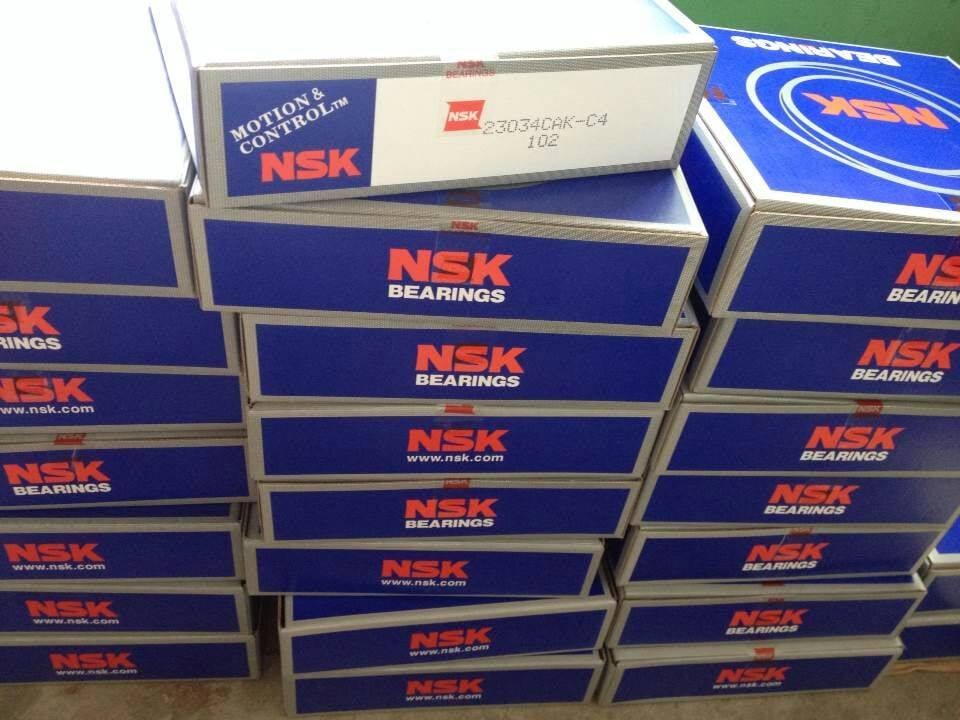
 News
NewsDue to the inaccurate measurement of the shaft diameter and the size of the bearing seat hole or the mating surface roughness does not meet the standard requirements, excessive interference fit is caused, and the nsk bearing seat ring is greatly squeezed, which causes the radial clearance of the bearing itself to decrease , Make the bearing difficult to rotate, heat up, wear aggravated or stuck, and in severe cases, it will cause the inner and outer races of the bearing to crack during installation. The non-rotating seat ring often adopts a fit with little clearance or interference. In this way, the non-rotating seat ring may produce a small creep, and the contact surface of the seat ring and the rolling element is constantly replaced, and the raceway of the seat ring wears evenly. At the same time, it can also eliminate the phenomenon of axial jamming of the rolling elements in the bearing due to thermal elongation of the shaft. However, an excessive clearance fit will cause the non-rotating race to rotate with the rolling elements, causing serious wear on the shaft (or bearing seat hole) and the inner race (or outer race), and friction will cause the bearing to heat and vibrate.
A. Improper assembly method
When the interference between the NSK bearing and the shaft diameter or the bearing seat hole is small, the press-fit assembly is often used. The easiest way is to use a copper rod and a hand hammer to strike the bearing races with interference fit symmetrically in a certain order, so that the bearing can be pressed in smoothly. In addition, a soft metal sleeve can be used to drive in with a hammer or press in. If the operation is improper, the seat ring will be deformed and cracked, or the hand hammer will be hit on the seat ring of non-interference fit, which will cause the raceway and rolling element to produce indentation or the bearing will be damaged indirectly.
B. Improper temperature control during assembly
When assembling NSK bearings, if they have a large interference with the shaft diameter, they are generally assembled by hot mounting. That is to say, the bearing is placed in an oil drum containing organic oil, and the outside of the oil drum is heated with hot water or flame. The process requires that the heating oil temperature is controlled at 80℃~90℃, generally not exceeding 100℃, and not exceeding 120℃ at most. After the bearing is heated, it is quickly taken out and sleeved on the journal. If the temperature is not properly controlled and the heating temperature is too high, it will cause the bearing to temper and reduce the hardness, and the bearing will be easily worn, peeled, and even cracked during operation.
C. Improper gap adjustment during assembly
The clearance of rolling bearings is divided into radial clearance and axial clearance. Its function is to ensure the normal operation and lubrication of rolling elements and compensate for thermal elongation.
For bearings with adjustable clearance, because there is a proportional relationship between the axial clearance and the radial clearance, the installation is as long as the axial clearance is adjusted to obtain the required radial clearance, and they are generally It is used in pairs (that is, installed on the two ends or one end of the shaft), therefore, only the axial clearance of one bearing needs to be adjusted. Generally use washers to adjust the axial gap, and some can also be adjusted with screws or thrust rings.
For NSK bearings with non-adjustable clearance, the radial clearance has been determined according to the standard during manufacture and cannot be adjusted. After this type of bearing is installed on the shaft diameter or in the bearing seat hole, the actual radial clearance is called Assemble the radial clearance, the size of the assembling radial clearance should be just enough to create the necessary working radial clearance during operation to ensure the flexible rotation of the bearing. When this type of bearing is working, the inner race is relatively displaced due to the heat elongation of the shaft when the temperature rises, so that the radial clearance of the bearing is reduced, and even the rolling elements are stuck between the inner and outer races. If an axial gap is left between one bearing (the other bearing is fixed on the shaft and in the bearing seat) and the side cover in the double-support rolling bearing, the above phenomenon can be avoided.
Contact us for more details about NSK 23034CAK-C4.

Phenomenon:
1) Under normal circumstances, there is no sound when the engine is running stably. When the engine speed changes suddenly, a dull "boring and boring" knocking sound will be emitted, accompanied by vibration.
2) When the engine load changes, the noise is obvious. The higher the speed, the louder the noise.
3) No change can be felt when a single cylinder is "frozen", but the sound will be significantly weakened when two adjacent cylinders are simultaneously misfired.
Reason:
1) The clearance between the crankshaft and the journal is too large.
2) The clearance between the crankshaft and the axial direction is too large.
3) The bolts of the crankshaft bearing cap are loose.
4) Poor lubrication of the crankshaft bearing and journal causes the bearing alloy to ablate and fall off and cause noise.
5) The crankshaft is bent and deformed, and the crankshaft journal is out of round.
6) The crankshaft bearing rotates relative to the bearing seat.